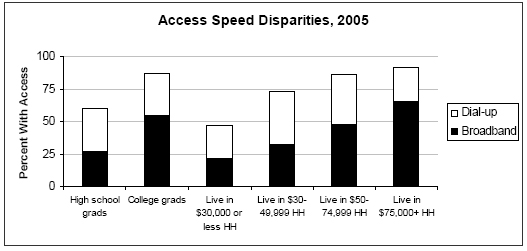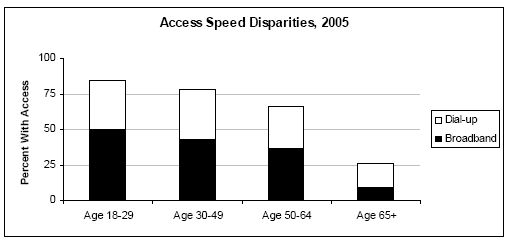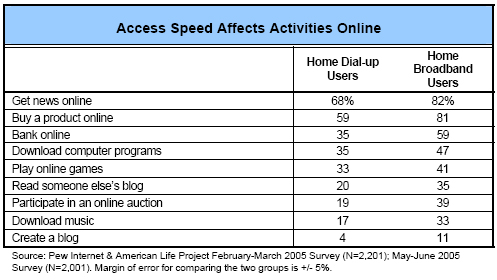Introduction
Fifty-three percent of home internet users now have a high-speed connection at home, up from 21% of internet users in 2002. Perhaps not surprisingly, people who are less likely to have access at all, such as older Americans, are also less likely to upgrade to broadband once they do get online.
Two-thirds of college graduates have broadband at home.
Fully 62% of home internet users with a college or graduate degree have a high-speed connection at home. That is notably higher than the 44% of home internet users with high school diplomas who have broadband connections.
“Broadband users” are those with a Digital Subscriber Line, cable modem, wireless connection, or fiber (T-1) connection.
In a similar pattern, internet users living in the highest-income households are not only the most likely to go online (93% have access), but are also the most likely group to have a fast connection – 71% of these internet users have a broadband connection at home. By contrast, adults living in households with annual incomes of $30,000 or less are about half as likely as the highest-income Americans to go online at all (49% have access), and only 42% of these internet users have high-speed access at home.10

The new “grey gap” is one of speed as well as access.
More than half of home internet users between 18 and 64 years old have a fast connection at home, compared with about one-third of internet users age 65 and older.
Americans age 65 and older are the least likely demographic group to have an internet connection and are continuing to lag younger users in access speeds as well. There is an elite group of wired seniors who are following their younger peers into the broadband future, but the majority of older Americans is completely offline or has a tenuous connection to the internet.11

Connection speed overtakes experience as the most significant predictor of online behavior.
Broadband access is now a more significant predictor of online behavior than years of online experience. Previously, the Pew Internet & American Life Project reported that if an internet user had three or more years of experience online, he was more likely to take part in a wide range of activities on a typical day. Now that most of the internet’s heaviest users have upgraded from dial-up to high-speed access at home, broadband users are pulling away from dial-up users in many aspects of online life, regardless of the years of online experience they might have.12

There are three degrees of internet access – cold, tepid, and hot.
One way to look at internet access in the U.S. is to split adults into three tiers – those who are truly offline, those with a relatively tenuous or modest connection to the internet, and those who are highly wired.
Twenty-two percent of American adults have never used the internet and do not live in households with internet access. They are likely to have a high school education or less and be over the age of 65. Few of these Americans have access anywhere to a computer on a regular basis, much less the internet. If they needed to get information from a Web site or other online source, they probably could not easily do so.
Forty percent of American adults have a somewhat loose connection to the internet. They may or may not go online regularly, but would probably be able to go online if they really needed to do so. This group includes dial-up users (30% of adults), people who live in internet-connected homes but do not go online themselves (5% of adults), and people who do not currently have access, but have in the past (5% of adults). They are more educated and younger than the offline group. There are clusters of enthusiastic users on dial-up or currently offline, but overall, these adults are less fervent in their internet use.
Thirty-three percent of American adults are highly engaged with the internet, going online via high-speed connections at home. They are likely to have attended college and be under age 50, but there are pockets of “wired seniors,” as well. Many of these internet users go online every day and have sampled a wide range of activities.




